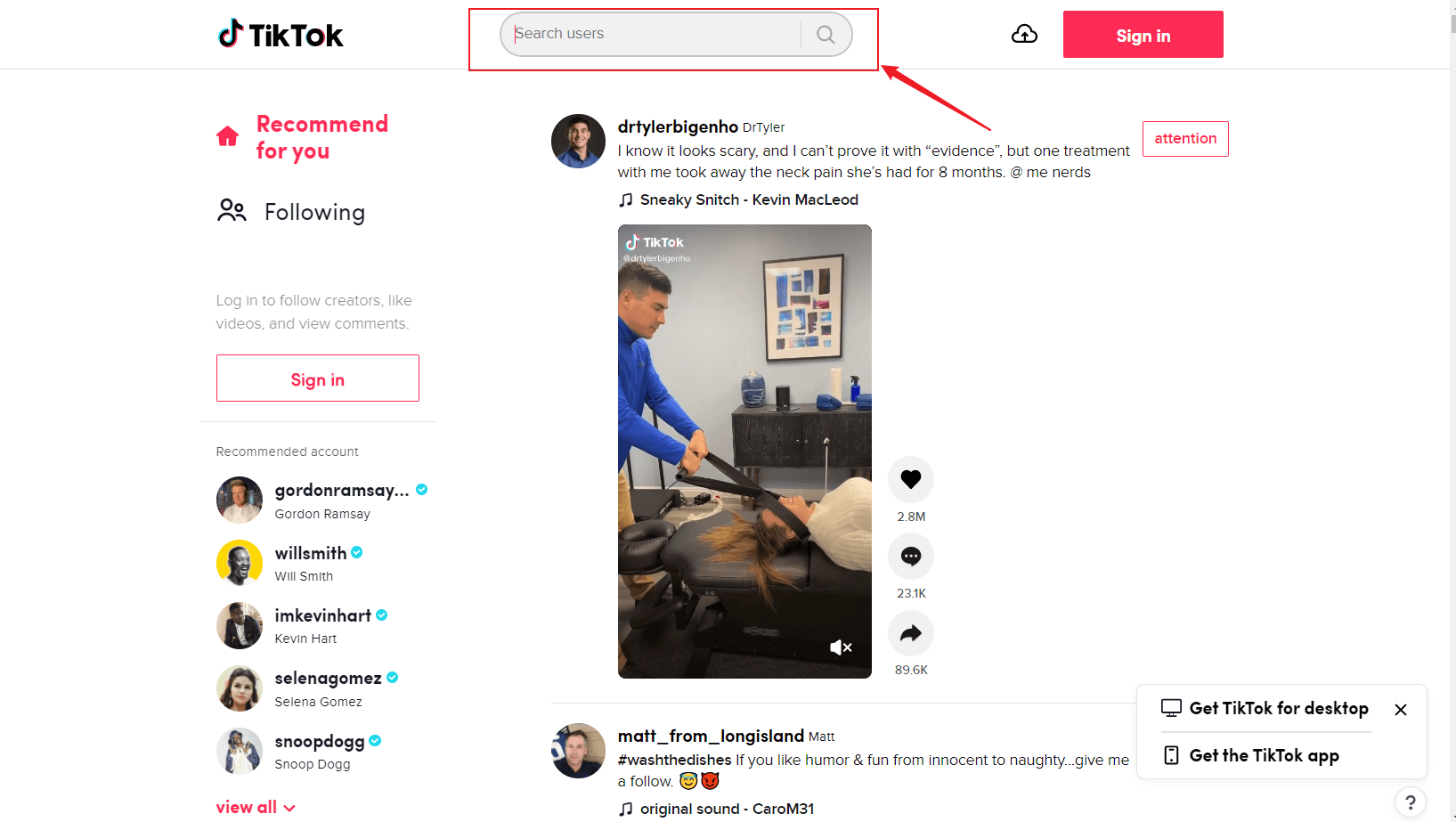!["[Updated] 2024 Approved Mastering the Mac Essential Tips for TikTok Users"](https://www.lifewire.com/thmb/FSEnoGCMAP0T58dNwB2d4-upLhA=/400x300/filters:no_upscale():max_bytes(150000):strip_icc()/GettyImages-688982955-596fff12519de200112ef724.jpg)
"[Updated] 2024 Approved Mastering the Mac Essential Tips for TikTok Users"

Mastering the Mac: Essential Tips for TikTok Users
5 Things You Should Know When Using TikTok Web on Mac

Shanoon Cox
Oct 26, 2023• Proven solutions
Android and iOS users can utilize TikTok fully but what if you have Mac? The good news for you is that Tiktok on Mac is available. Many users know they can access TikTok Web from Mac so we are here to answer any questions that you might have.
TikTok is an exciting and entertaining platform that will allow you to connect to people globally. Apart from using the app on your phone, you can use the website on Mac to see videos and even upload your own. In this article, we will show you the most frequent tips you should know when using the TikTok Web on Mac.
- How to Use TikTok on Mac?
- What Should You Do if TikTok Web Stops Functioning Properly?
- How Can You Find Someone on TikTok Web?
- Can You use TikTok Live on Mac?
- How to Upload Videos on TikTok Web from Mac?
Pointers for Using TikTok on Mac
Are you finding it impossible to find information about using TikTok on Mac and are near to giving up? Do not despair just yet because we have gathered most of the information for you.
1. How to Use TikTok on Mac?
You can use TikTok on your Mac through the official website of TikTok.
- Open your web browser and go to the official website where you will need to log in.
- You will find the Log in button on the top right of the window.
- Once you have entered your login details, you will be able to enjoy the platform.

We would like to add that when you are using TikTok on your Mac, you can upload already edited videos without any trouble. There is not one specified Tiktok video editing software available but you can utilize Wondershare Filmora for Mac as that seems to be the top choice among users these days.
2. What Should You Do if TikTok Web Stops Functioning Properly?
The technology behind TikTok is pretty much flawless. If the website is not working, then we would recommend:
- That you check your internet connection. A stable internet connection will give you the best user experience.
- If the website is still is not loading then go to the browser’s settings and clear out related caches and cookies.
If you are facing some other kind of problem then you can always directly contact the support team at TikTok.
- Go to your profile by clicking on Me.

- You will see Three dots which will take you to the option of Report a problem.
- You will be asked to look for the solution to your problem by looking into the existing suggested topics.
- If your issue is not listed there then click on No when asked: “if your problem has been resolved”. The company will contact you shortly afterward to solve your matter.
3. How Can You Find Someone on TikTok Web?
The process of finding your friend or someone else on the TikTok website is not all that difficult. The creators of the platform have tried their best to make the interface user-friendly. If you know the user ID then:
- Tap on the Discover (Magnifying glass icon) which will take you to a search bar.

- Simply type the user ID in there and you see the individual’s account listed.
- Simply go to the account and follow/view the profile.
If you are unaware of the username then there is one more method:
- Go to the section “find Facebook friends” on the website.
- If the friend that you are looking for also uses Facebook then you would be able to find and connect with them easily.

4. Can You use TikTok Live on Mac?
Unfortunately, you cannot go live from your Mac on TikTok. As of now, TikTok has not allowed users to record videos or go live from the webcam of their computer. Whilst you cannot use your Mac to go live, you can always do it from your smartphone or tablet.
5. How to Upload Videos on TikTok Web from Mac?
The process of uploading a video on your profile using the website TikTok is fairly easy even if you are using a Mac.
- Once you log into your account on the website, you will see a Cloud shape with an arrow pointing downward.

- After you click on it, you will be asked to upload a video. We would advise you to be clever and upload an edited video (you can useFilmora Video Editor for editing ). Make sure that the resolution of the video is more than 720p and the duration should be between 3-60 seconds.
- Next, you will input the caption of your video; make sure that it is eye-catching.
- To attract views, find the perfect cover for your video and choose it by dragging it onto the screen.
- After that, adjust the privacy settings according to your preference, it will determine who can and cannot view your content.
- Lastly, choose the Upload button and your video will be uploaded to your feed.
TikTok Web on Mac
You can enjoy almost every feature of TikTok on Mac but there are still some things that you cannot do. A few we have mentioned above but did you know that you will need to use Wondershare Filmora for Mac or a similar video editing software if you wish to make any changes to your video?
TikTok has not yet allowed the editing of videos on their website. It might seem like a setback but it is not. You can use one of the best video editors for Tiktok web-like Filmora video editor to add in transitions, export, import, and do all other sorts of effects.
You May Also Like: How to Use TikTok on Mac and PC Computers?
You May Also Like: How to Clone Yourself on TikTok

Shanoon Cox
Shanoon Cox is a writer and a lover of all things video.
Follow @Shanoon Cox
Shanoon Cox
Oct 26, 2023• Proven solutions
Android and iOS users can utilize TikTok fully but what if you have Mac? The good news for you is that Tiktok on Mac is available. Many users know they can access TikTok Web from Mac so we are here to answer any questions that you might have.
TikTok is an exciting and entertaining platform that will allow you to connect to people globally. Apart from using the app on your phone, you can use the website on Mac to see videos and even upload your own. In this article, we will show you the most frequent tips you should know when using the TikTok Web on Mac.
- How to Use TikTok on Mac?
- What Should You Do if TikTok Web Stops Functioning Properly?
- How Can You Find Someone on TikTok Web?
- Can You use TikTok Live on Mac?
- How to Upload Videos on TikTok Web from Mac?
Pointers for Using TikTok on Mac
Are you finding it impossible to find information about using TikTok on Mac and are near to giving up? Do not despair just yet because we have gathered most of the information for you.
1. How to Use TikTok on Mac?
You can use TikTok on your Mac through the official website of TikTok.
- Open your web browser and go to the official website where you will need to log in.
- You will find the Log in button on the top right of the window.
- Once you have entered your login details, you will be able to enjoy the platform.

We would like to add that when you are using TikTok on your Mac, you can upload already edited videos without any trouble. There is not one specified Tiktok video editing software available but you can utilize Wondershare Filmora for Mac as that seems to be the top choice among users these days.
2. What Should You Do if TikTok Web Stops Functioning Properly?
The technology behind TikTok is pretty much flawless. If the website is not working, then we would recommend:
- That you check your internet connection. A stable internet connection will give you the best user experience.
- If the website is still is not loading then go to the browser’s settings and clear out related caches and cookies.
If you are facing some other kind of problem then you can always directly contact the support team at TikTok.
- Go to your profile by clicking on Me.

- You will see Three dots which will take you to the option of Report a problem.
- You will be asked to look for the solution to your problem by looking into the existing suggested topics.
- If your issue is not listed there then click on No when asked: “if your problem has been resolved”. The company will contact you shortly afterward to solve your matter.
3. How Can You Find Someone on TikTok Web?
The process of finding your friend or someone else on the TikTok website is not all that difficult. The creators of the platform have tried their best to make the interface user-friendly. If you know the user ID then:
- Tap on the Discover (Magnifying glass icon) which will take you to a search bar.

- Simply type the user ID in there and you see the individual’s account listed.
- Simply go to the account and follow/view the profile.
If you are unaware of the username then there is one more method:
- Go to the section “find Facebook friends” on the website.
- If the friend that you are looking for also uses Facebook then you would be able to find and connect with them easily.

4. Can You use TikTok Live on Mac?
Unfortunately, you cannot go live from your Mac on TikTok. As of now, TikTok has not allowed users to record videos or go live from the webcam of their computer. Whilst you cannot use your Mac to go live, you can always do it from your smartphone or tablet.
5. How to Upload Videos on TikTok Web from Mac?
The process of uploading a video on your profile using the website TikTok is fairly easy even if you are using a Mac.
- Once you log into your account on the website, you will see a Cloud shape with an arrow pointing downward.

- After you click on it, you will be asked to upload a video. We would advise you to be clever and upload an edited video (you can useFilmora Video Editor for editing ). Make sure that the resolution of the video is more than 720p and the duration should be between 3-60 seconds.
- Next, you will input the caption of your video; make sure that it is eye-catching.
- To attract views, find the perfect cover for your video and choose it by dragging it onto the screen.
- After that, adjust the privacy settings according to your preference, it will determine who can and cannot view your content.
- Lastly, choose the Upload button and your video will be uploaded to your feed.
TikTok Web on Mac
You can enjoy almost every feature of TikTok on Mac but there are still some things that you cannot do. A few we have mentioned above but did you know that you will need to use Wondershare Filmora for Mac or a similar video editing software if you wish to make any changes to your video?
TikTok has not yet allowed the editing of videos on their website. It might seem like a setback but it is not. You can use one of the best video editors for Tiktok web-like Filmora video editor to add in transitions, export, import, and do all other sorts of effects.
You May Also Like: How to Use TikTok on Mac and PC Computers?
You May Also Like: How to Clone Yourself on TikTok

Shanoon Cox
Shanoon Cox is a writer and a lover of all things video.
Follow @Shanoon Cox
Shanoon Cox
Oct 26, 2023• Proven solutions
Android and iOS users can utilize TikTok fully but what if you have Mac? The good news for you is that Tiktok on Mac is available. Many users know they can access TikTok Web from Mac so we are here to answer any questions that you might have.
TikTok is an exciting and entertaining platform that will allow you to connect to people globally. Apart from using the app on your phone, you can use the website on Mac to see videos and even upload your own. In this article, we will show you the most frequent tips you should know when using the TikTok Web on Mac.
- How to Use TikTok on Mac?
- What Should You Do if TikTok Web Stops Functioning Properly?
- How Can You Find Someone on TikTok Web?
- Can You use TikTok Live on Mac?
- How to Upload Videos on TikTok Web from Mac?
Pointers for Using TikTok on Mac
Are you finding it impossible to find information about using TikTok on Mac and are near to giving up? Do not despair just yet because we have gathered most of the information for you.
1. How to Use TikTok on Mac?
You can use TikTok on your Mac through the official website of TikTok.
- Open your web browser and go to the official website where you will need to log in.
- You will find the Log in button on the top right of the window.
- Once you have entered your login details, you will be able to enjoy the platform.

We would like to add that when you are using TikTok on your Mac, you can upload already edited videos without any trouble. There is not one specified Tiktok video editing software available but you can utilize Wondershare Filmora for Mac as that seems to be the top choice among users these days.
2. What Should You Do if TikTok Web Stops Functioning Properly?
The technology behind TikTok is pretty much flawless. If the website is not working, then we would recommend:
- That you check your internet connection. A stable internet connection will give you the best user experience.
- If the website is still is not loading then go to the browser’s settings and clear out related caches and cookies.
If you are facing some other kind of problem then you can always directly contact the support team at TikTok.
- Go to your profile by clicking on Me.

- You will see Three dots which will take you to the option of Report a problem.
- You will be asked to look for the solution to your problem by looking into the existing suggested topics.
- If your issue is not listed there then click on No when asked: “if your problem has been resolved”. The company will contact you shortly afterward to solve your matter.
3. How Can You Find Someone on TikTok Web?
The process of finding your friend or someone else on the TikTok website is not all that difficult. The creators of the platform have tried their best to make the interface user-friendly. If you know the user ID then:
- Tap on the Discover (Magnifying glass icon) which will take you to a search bar.

- Simply type the user ID in there and you see the individual’s account listed.
- Simply go to the account and follow/view the profile.
If you are unaware of the username then there is one more method:
- Go to the section “find Facebook friends” on the website.
- If the friend that you are looking for also uses Facebook then you would be able to find and connect with them easily.

4. Can You use TikTok Live on Mac?
Unfortunately, you cannot go live from your Mac on TikTok. As of now, TikTok has not allowed users to record videos or go live from the webcam of their computer. Whilst you cannot use your Mac to go live, you can always do it from your smartphone or tablet.
5. How to Upload Videos on TikTok Web from Mac?
The process of uploading a video on your profile using the website TikTok is fairly easy even if you are using a Mac.
- Once you log into your account on the website, you will see a Cloud shape with an arrow pointing downward.

- After you click on it, you will be asked to upload a video. We would advise you to be clever and upload an edited video (you can useFilmora Video Editor for editing ). Make sure that the resolution of the video is more than 720p and the duration should be between 3-60 seconds.
- Next, you will input the caption of your video; make sure that it is eye-catching.
- To attract views, find the perfect cover for your video and choose it by dragging it onto the screen.
- After that, adjust the privacy settings according to your preference, it will determine who can and cannot view your content.
- Lastly, choose the Upload button and your video will be uploaded to your feed.
TikTok Web on Mac
You can enjoy almost every feature of TikTok on Mac but there are still some things that you cannot do. A few we have mentioned above but did you know that you will need to use Wondershare Filmora for Mac or a similar video editing software if you wish to make any changes to your video?
TikTok has not yet allowed the editing of videos on their website. It might seem like a setback but it is not. You can use one of the best video editors for Tiktok web-like Filmora video editor to add in transitions, export, import, and do all other sorts of effects.
You May Also Like: How to Use TikTok on Mac and PC Computers?
You May Also Like: How to Clone Yourself on TikTok

Shanoon Cox
Shanoon Cox is a writer and a lover of all things video.
Follow @Shanoon Cox
Shanoon Cox
Oct 26, 2023• Proven solutions
Android and iOS users can utilize TikTok fully but what if you have Mac? The good news for you is that Tiktok on Mac is available. Many users know they can access TikTok Web from Mac so we are here to answer any questions that you might have.
TikTok is an exciting and entertaining platform that will allow you to connect to people globally. Apart from using the app on your phone, you can use the website on Mac to see videos and even upload your own. In this article, we will show you the most frequent tips you should know when using the TikTok Web on Mac.
- How to Use TikTok on Mac?
- What Should You Do if TikTok Web Stops Functioning Properly?
- How Can You Find Someone on TikTok Web?
- Can You use TikTok Live on Mac?
- How to Upload Videos on TikTok Web from Mac?
Pointers for Using TikTok on Mac
Are you finding it impossible to find information about using TikTok on Mac and are near to giving up? Do not despair just yet because we have gathered most of the information for you.
1. How to Use TikTok on Mac?
You can use TikTok on your Mac through the official website of TikTok.
- Open your web browser and go to the official website where you will need to log in.
- You will find the Log in button on the top right of the window.
- Once you have entered your login details, you will be able to enjoy the platform.

We would like to add that when you are using TikTok on your Mac, you can upload already edited videos without any trouble. There is not one specified Tiktok video editing software available but you can utilize Wondershare Filmora for Mac as that seems to be the top choice among users these days.
2. What Should You Do if TikTok Web Stops Functioning Properly?
The technology behind TikTok is pretty much flawless. If the website is not working, then we would recommend:
- That you check your internet connection. A stable internet connection will give you the best user experience.
- If the website is still is not loading then go to the browser’s settings and clear out related caches and cookies.
If you are facing some other kind of problem then you can always directly contact the support team at TikTok.
- Go to your profile by clicking on Me.

- You will see Three dots which will take you to the option of Report a problem.
- You will be asked to look for the solution to your problem by looking into the existing suggested topics.
- If your issue is not listed there then click on No when asked: “if your problem has been resolved”. The company will contact you shortly afterward to solve your matter.
3. How Can You Find Someone on TikTok Web?
The process of finding your friend or someone else on the TikTok website is not all that difficult. The creators of the platform have tried their best to make the interface user-friendly. If you know the user ID then:
- Tap on the Discover (Magnifying glass icon) which will take you to a search bar.

- Simply type the user ID in there and you see the individual’s account listed.
- Simply go to the account and follow/view the profile.
If you are unaware of the username then there is one more method:
- Go to the section “find Facebook friends” on the website.
- If the friend that you are looking for also uses Facebook then you would be able to find and connect with them easily.

4. Can You use TikTok Live on Mac?
Unfortunately, you cannot go live from your Mac on TikTok. As of now, TikTok has not allowed users to record videos or go live from the webcam of their computer. Whilst you cannot use your Mac to go live, you can always do it from your smartphone or tablet.
5. How to Upload Videos on TikTok Web from Mac?
The process of uploading a video on your profile using the website TikTok is fairly easy even if you are using a Mac.
- Once you log into your account on the website, you will see a Cloud shape with an arrow pointing downward.

- After you click on it, you will be asked to upload a video. We would advise you to be clever and upload an edited video (you can useFilmora Video Editor for editing ). Make sure that the resolution of the video is more than 720p and the duration should be between 3-60 seconds.
- Next, you will input the caption of your video; make sure that it is eye-catching.
- To attract views, find the perfect cover for your video and choose it by dragging it onto the screen.
- After that, adjust the privacy settings according to your preference, it will determine who can and cannot view your content.
- Lastly, choose the Upload button and your video will be uploaded to your feed.
TikTok Web on Mac
You can enjoy almost every feature of TikTok on Mac but there are still some things that you cannot do. A few we have mentioned above but did you know that you will need to use Wondershare Filmora for Mac or a similar video editing software if you wish to make any changes to your video?
TikTok has not yet allowed the editing of videos on their website. It might seem like a setback but it is not. You can use one of the best video editors for Tiktok web-like Filmora video editor to add in transitions, export, import, and do all other sorts of effects.
You May Also Like: How to Use TikTok on Mac and PC Computers?
You May Also Like: How to Clone Yourself on TikTok

Shanoon Cox
Shanoon Cox is a writer and a lover of all things video.
Follow @Shanoon Cox
A Step-by-Step Guide to Remove Background Noise From Your Recordings in Audacity
The most frequent request you’ll get from video makers is to eliminate irritating noises like rumbling or humming from an original clip. Almost all of the time, capturing high-quality audio during filming is challenging since the conversation is often hard to hear or is made unclear due to surrounding noises, such as the dreadful air conditioners or fans.
To get rid of all these awful noises, this Audacity Noise Reduction feature will serve you a significant purpose in removing unwanted background noise for your future videos. Without further ado, let’s get started!
In this article
01 Things You Need to Prepare for Background Noise Reduction
02 How to Remove Background Noise in Audacity?
03 Why is Audacity Noise Reduction Not Working?
04 How to Prevent Background Noise in Audio Recording?
05 How to Remove Background Noise in Filmora?
Part 1: Things You Need to Prepare for Background Noise Reduction
Here are few things that you need to consider before you apply the noise reduction to your clips:
1. Noise Sample
A decent sample of the noise you wish to eliminate is perhaps the most crucial aspect of the Audacity remove noise procedure.
This will be used by Audacity to understand the noise and build a noise profile. The noise recording should last for a fair amount of time and be devoid of any other noises.
2. Avoid Copy Pasting Tiny Noise Section in Your Spoken Phrases
When you have a tiny part of noise between your stated words on your audio, please don’t copy/paste it to make a more significant piece of sound for Audacity to examine.
You would not be supplying Audacity with any more information that will help it generate a decent noise profile. The noise profile is what enables Audacity to tell the difference between speech and noise.
3. Minimum 2048 Data Samples Required
To build a noise profile, the Noise Reduction function requires a minimum of 2048 sample data. An audio file with a sampling frequency of 44.1kHz is roughly five hundredths of a second.
Note that this is the minor sound level that Audacity needs to generate a noise profile; however, should you supply a larger sample of the noise, Audacity can typically perform a great job of producing a suitable noise profile. As a result, attempt to capture a few seconds of background noises wherever possible.
4. Establish Recording Level and Record “Silence”
Setting your audio volume and capturing some “quiet” prior to speaking is the best way to achieve this. Instead, when you’ve finished talking, keep your camera/recorder going for a few moments.
Don’t move or create any sounds while capturing the background noises, and keep an ear open for any other noises. You only need to capture the ambient noise for a few moments; two to five seconds will suffice.
Part 2: How to Remove Background Noise in Audacity on Windows and Mac?
Whether you are using Windows or macOS, we will show you a step-by-step process to achieve your results using both software in this part of Audacity remove background music guide.
Remove background noise in Audacity on Windows
Step 1: On your recording, select a few moments of sound. Any segment of noise that incorporates other noises should be avoided.
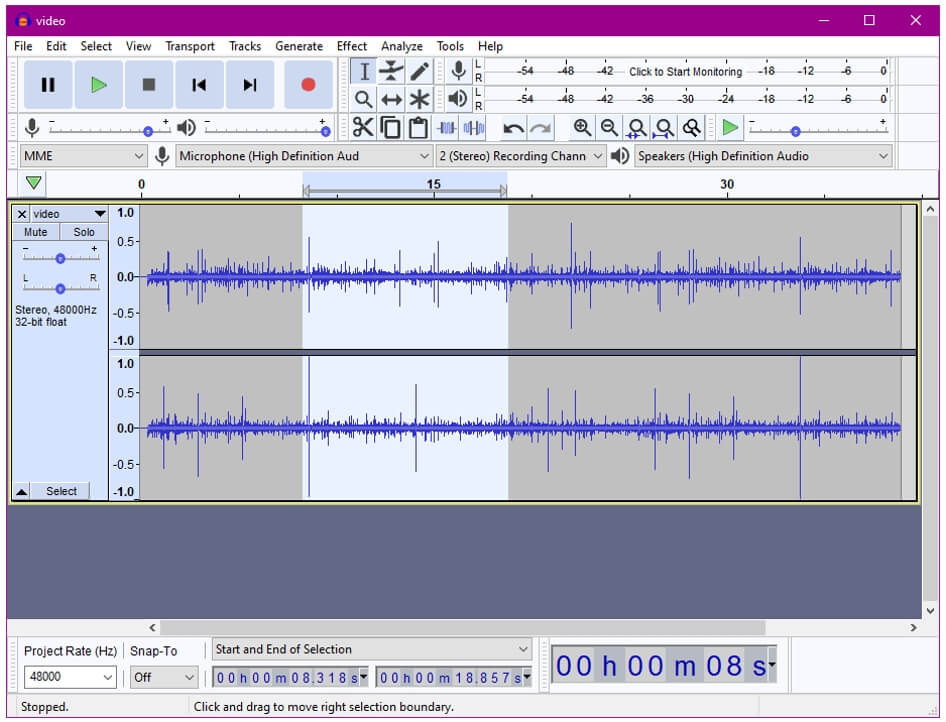
Step 2: From the Effect menu, select Noise Reduction.
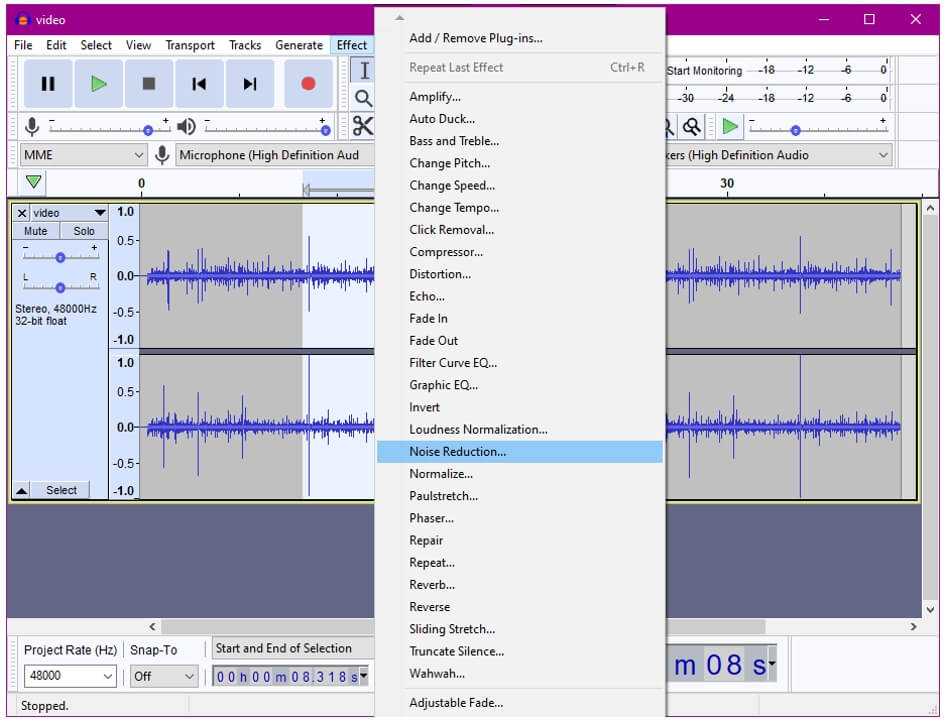
Step 3: Select the Get Noise Profile option whenever the Noise Reduction effect screen appears.
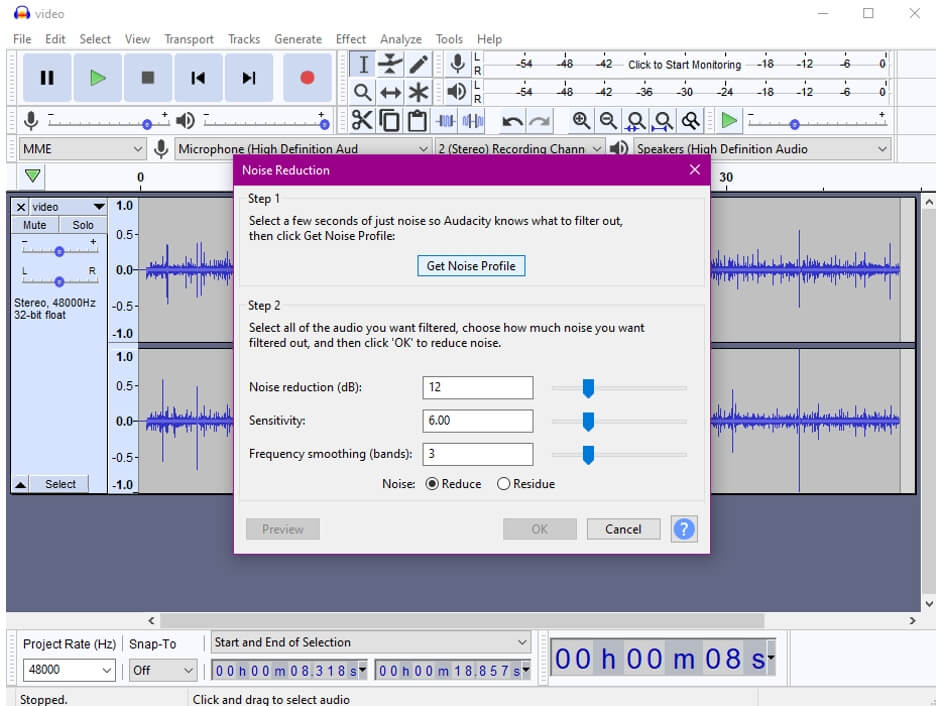
Note: Choose whether to implement the noise removal to the entire waveforms or only a portion of it.
Step 4: To access the Noise Reduction effects window, go to Effects > Noise Reduction. Raise the level of noise reduction progressively while previewing the result.
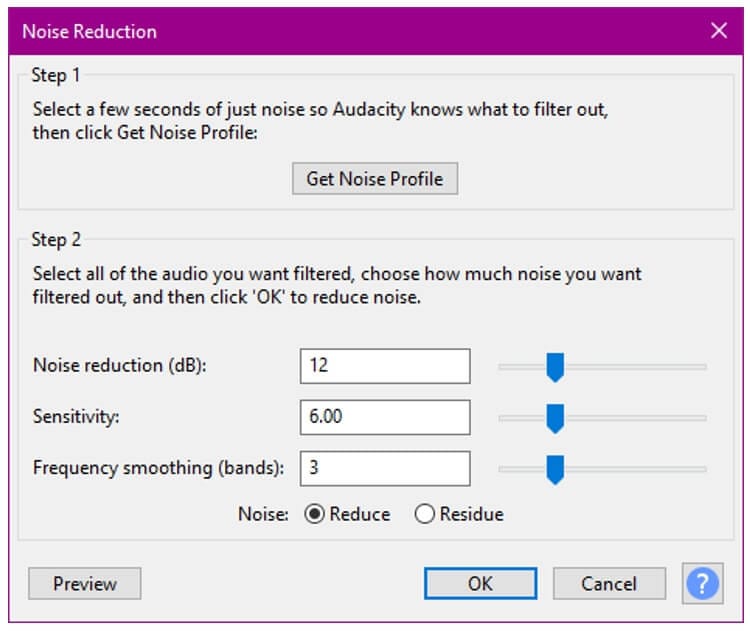
Step 5: Head over to the File section to Export and Save the result. Audacity does not save sound clips when you select Save Project; instead, you must choose Export. Select the file type you want to store and the place wherever you can save it. Select Save after giving the File Name.
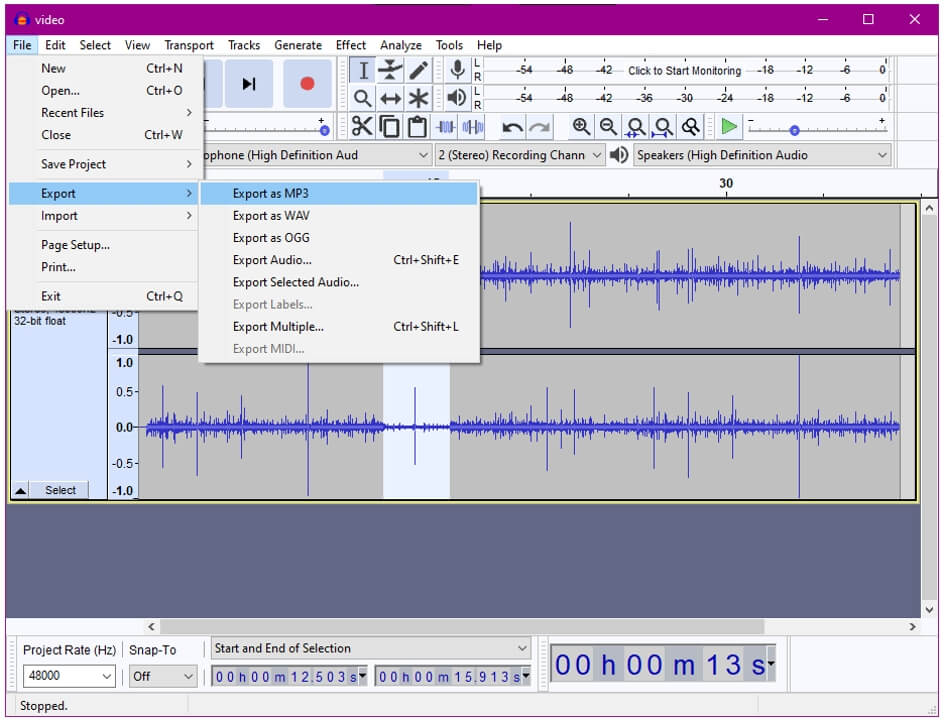
Remove background noise in Audacity on Mac
Step 1: Create a room tone-containing audio file. When you don’t have a separate track for room tone, use a recording with a few moments of quiet in it. Click-and-drag to select a segment with a few minutes of silence using the Selection Tool.
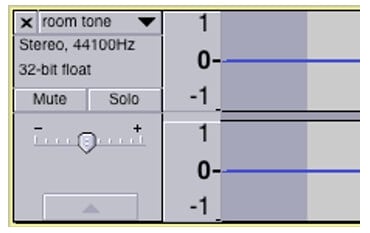
Step 2: Select Noise Reduction from the Effects tab. Select the Get Noise Profile tab in the new tab under Step 1. The screen will shut, and Audacity will take noise profile samples of the indicated area.

Step 3: Click-and-drag to select the whole file, which requires noise reduction with the Selection Tool. To re-open the function, go to the Effect tab and pick Noise Reduction. Make modifications to the following parameters under Step 2:
- Reduce and Residue
- Frequency Smoothing (bands)
- Sensitivity
- Noise Reduction
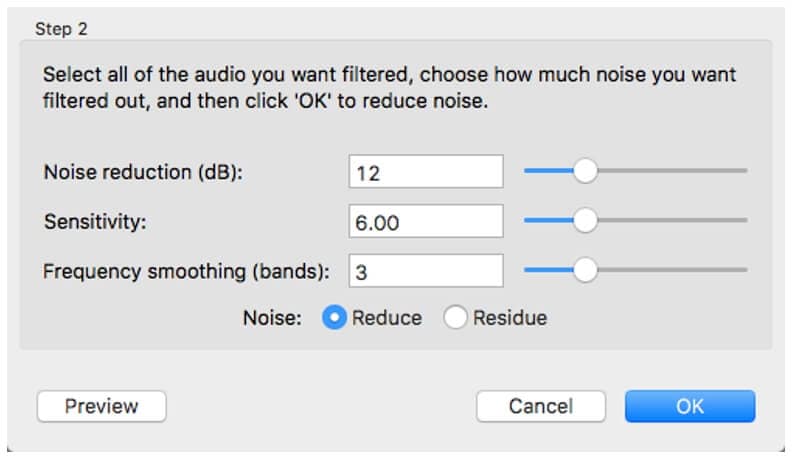
Step 4: To listen to how the chosen file will look with the selected parameters, select Preview. Re-adjust until you have a sound noise reduction with no interference. When you’re finished, select Reduce and click OK.
Part 3: Why is Audacity Noise Reduction Not Working?
It’s possible that the Noise Reduction function isn’t letting you mop up your recording since your audio isn’t appropriate for it. The disturbance must be continuous, not random or fluctuating, to work for Audacity’s Noise Reduction function.
For example, the Noise Reduction function will not assist if your audio was made in a busy environment with unique noises such as background chatter, random traffic noises, or in an exhibition space or museum. The Noise Reduction feature in Audacity isn’t meant to cope with that kind of distortion. You’ll need to alter your recording approach if you’re capturing voice in either of those situations.
Under the following situations, the Audacity Noise Reduction function might underperform.
- Particular noise in the background, including traffic or people.
- When the harmonics of the sound and voice are comparable.
- There is sound variance where there is fluctuation in the noise.
- The volume of the voice is comparable to or lower than that of the background noise.
- When the noise is irregular or changeable rather than continuous.
- The loudness is deafening.
- The sound is a single click or pop.
Part 4: How to Prevent Background Noise in Audio Recording?
Although Audacity allows eliminating noise very simply, it is still an additional level that takes time to refine your podcast production. These pointers can help you avoid the necessity for noise reduction and cut down on the amount of time you spend processing.
1. Reduce the Computer Fan Noise
Whenever computers become too heated, they can produce a lot of noise. You may limit the amount of software that runs and position your mic away from the keyboard to help lessen this impact and avoid the fan from coming on.
However, even if you observe all of these guidelines, undesired recording sounds may still appear in your program. Fortunately, contemporary software makes this problem quite simple to resolve.
2. Reduce the Gain and Get Close to the Mic
Reduce the gain (sensitivity of the microphone) and go nearer to it. Talking straight into the microphone won’t distort your audio if you reduce the gain, and that would assist your microphone in concentrating on scooping up your voice’s tone.
Bonus Tip: Set your recorder’s (or DAW’s) sensitivity such that your speech peaks between -12 and -10db.
3. Utilize a Versatile Microphone
Condenser and dynamic microphones are the two most common types of podcast microphones. Condenser microphones are significantly more sensitive instruments meant to take up average atmospheric noise, whereas dynamic microphones have a narrower frequency range, picking up fewer ambient noises.
4. Optimize Your Recording Environment
The most significant and most crucial aspect of your podcasts’ sound quality is where you capture it. To optimize your personal podcasting space, we recommend choosing a peaceful, compact area away from HVAC systems, vehicles, external hard drives, background sound, motors, and other distractions. You may also increase the tone of your room by using natural sound absorbents such as curtains, rugs, carpets, and sofas.
Part 5: How to Remove Background Noise in Filmora?
Although there is a lot of software available to eliminate ambient noise, we highly suggest Wondershare Filmora Video Editor to edit audio and video in one place.
In addition to the standard audio editing capabilities, the recently redesigned Filmora currently includes enhanced waveforms, volume Keyframing , peak metering, and audio transitions, giving you a better audio editing interface.
For Win 7 or later (64-bit)
For macOS 10.12 or later
Filmora Video Editor will quickly remove ambient sound from both sound/video. You may also remove the sound from the video with this simple video editor, use the Audio Equalizer or Audio Mixer functions to modify the audio further, and then Export and save the audio in an Mp3 file. Here are the detailed steps:
Step 1: In the Wondershare Filmora Timeline menu, Import your footage. Trim the footage after previewing it and deleting the sections you don’t want to retain.
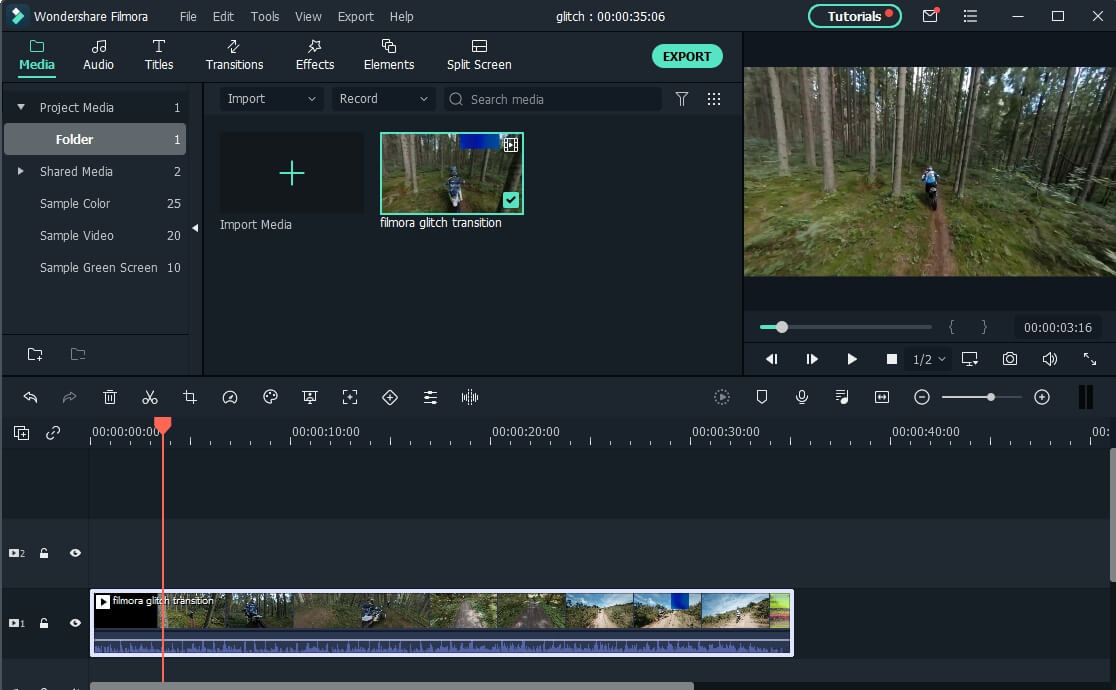
Step 2: To eliminate the ambient noise immediately, double-click on the video file, and go to the Audio panel to select the Remove Background Noise option. You will find that the background noise is removed automatically.
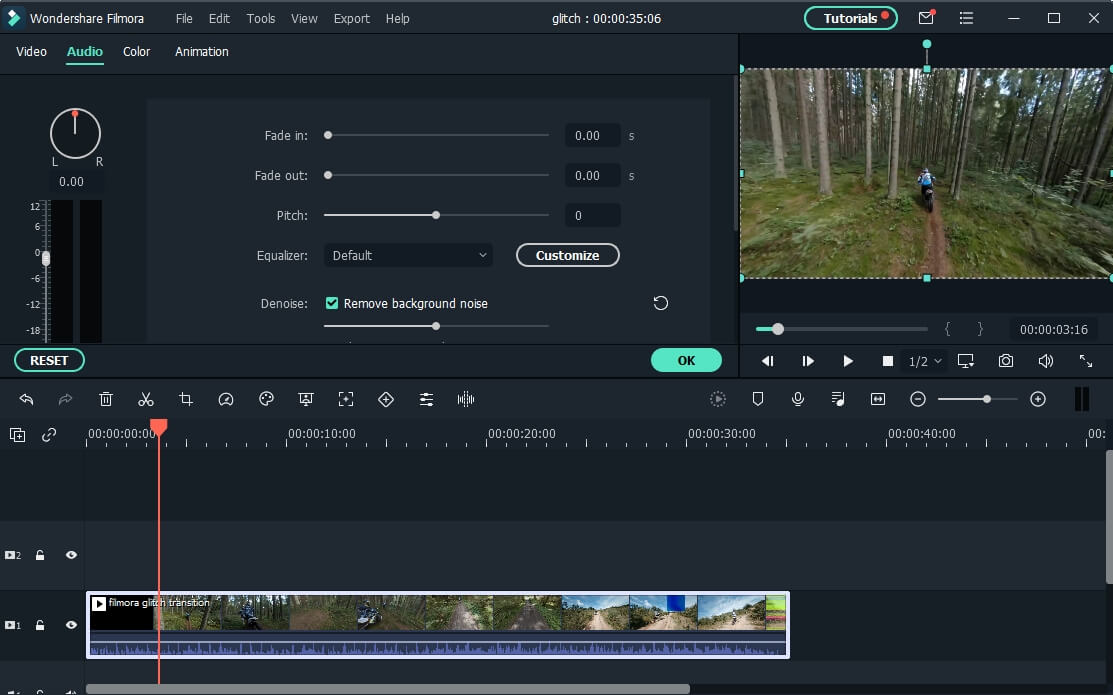
Step 3: After checking the results, select Export to download the noise-reduced clip to your desktop or upload it immediately to YouTube or Vimeo.
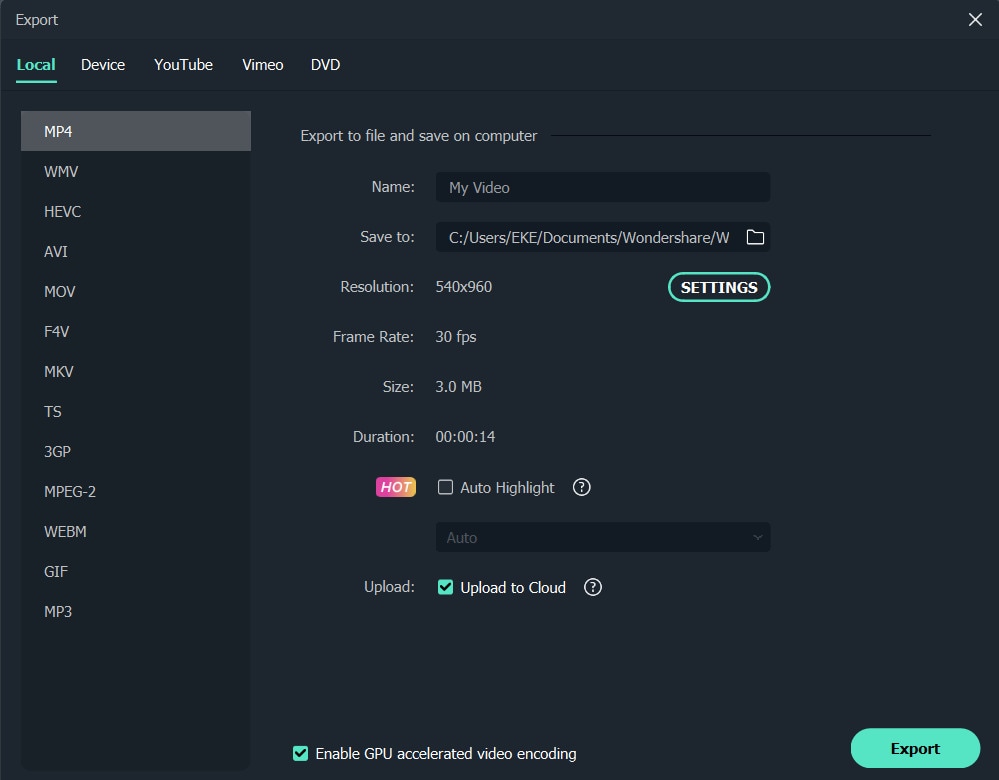
Conclusion
Well, there you have it. In this Audacity Remove Background Noise guide, we have reviewed every possible method you can adopt to get rid of the unnecessary background noise in the Audacity. And if the desired results are still not achieved, we highly recommend using the Wondershare Filmora editing software. Not only will it help you remove the unwanted ambient noise, but it will also allow you to customize your audio or video file further.
02 How to Remove Background Noise in Audacity?
03 Why is Audacity Noise Reduction Not Working?
04 How to Prevent Background Noise in Audio Recording?
05 How to Remove Background Noise in Filmora?
Part 1: Things You Need to Prepare for Background Noise Reduction
Here are few things that you need to consider before you apply the noise reduction to your clips:
1. Noise Sample
A decent sample of the noise you wish to eliminate is perhaps the most crucial aspect of the Audacity remove noise procedure.
This will be used by Audacity to understand the noise and build a noise profile. The noise recording should last for a fair amount of time and be devoid of any other noises.
2. Avoid Copy Pasting Tiny Noise Section in Your Spoken Phrases
When you have a tiny part of noise between your stated words on your audio, please don’t copy/paste it to make a more significant piece of sound for Audacity to examine.
You would not be supplying Audacity with any more information that will help it generate a decent noise profile. The noise profile is what enables Audacity to tell the difference between speech and noise.
3. Minimum 2048 Data Samples Required
To build a noise profile, the Noise Reduction function requires a minimum of 2048 sample data. An audio file with a sampling frequency of 44.1kHz is roughly five hundredths of a second.
Note that this is the minor sound level that Audacity needs to generate a noise profile; however, should you supply a larger sample of the noise, Audacity can typically perform a great job of producing a suitable noise profile. As a result, attempt to capture a few seconds of background noises wherever possible.
4. Establish Recording Level and Record “Silence”
Setting your audio volume and capturing some “quiet” prior to speaking is the best way to achieve this. Instead, when you’ve finished talking, keep your camera/recorder going for a few moments.
Don’t move or create any sounds while capturing the background noises, and keep an ear open for any other noises. You only need to capture the ambient noise for a few moments; two to five seconds will suffice.
Part 2: How to Remove Background Noise in Audacity on Windows and Mac?
Whether you are using Windows or macOS, we will show you a step-by-step process to achieve your results using both software in this part of Audacity remove background music guide.
Remove background noise in Audacity on Windows
Step 1: On your recording, select a few moments of sound. Any segment of noise that incorporates other noises should be avoided.

Step 2: From the Effect menu, select Noise Reduction.

Step 3: Select the Get Noise Profile option whenever the Noise Reduction effect screen appears.

Note: Choose whether to implement the noise removal to the entire waveforms or only a portion of it.
Step 4: To access the Noise Reduction effects window, go to Effects > Noise Reduction. Raise the level of noise reduction progressively while previewing the result.

Step 5: Head over to the File section to Export and Save the result. Audacity does not save sound clips when you select Save Project; instead, you must choose Export. Select the file type you want to store and the place wherever you can save it. Select Save after giving the File Name.

Remove background noise in Audacity on Mac
Step 1: Create a room tone-containing audio file. When you don’t have a separate track for room tone, use a recording with a few moments of quiet in it. Click-and-drag to select a segment with a few minutes of silence using the Selection Tool.

Step 2: Select Noise Reduction from the Effects tab. Select the Get Noise Profile tab in the new tab under Step 1. The screen will shut, and Audacity will take noise profile samples of the indicated area.

Step 3: Click-and-drag to select the whole file, which requires noise reduction with the Selection Tool. To re-open the function, go to the Effect tab and pick Noise Reduction. Make modifications to the following parameters under Step 2:
- Reduce and Residue
- Frequency Smoothing (bands)
- Sensitivity
- Noise Reduction

Step 4: To listen to how the chosen file will look with the selected parameters, select Preview. Re-adjust until you have a sound noise reduction with no interference. When you’re finished, select Reduce and click OK.
Part 3: Why is Audacity Noise Reduction Not Working?
It’s possible that the Noise Reduction function isn’t letting you mop up your recording since your audio isn’t appropriate for it. The disturbance must be continuous, not random or fluctuating, to work for Audacity’s Noise Reduction function.
For example, the Noise Reduction function will not assist if your audio was made in a busy environment with unique noises such as background chatter, random traffic noises, or in an exhibition space or museum. The Noise Reduction feature in Audacity isn’t meant to cope with that kind of distortion. You’ll need to alter your recording approach if you’re capturing voice in either of those situations.
Under the following situations, the Audacity Noise Reduction function might underperform.
- Particular noise in the background, including traffic or people.
- When the harmonics of the sound and voice are comparable.
- There is sound variance where there is fluctuation in the noise.
- The volume of the voice is comparable to or lower than that of the background noise.
- When the noise is irregular or changeable rather than continuous.
- The loudness is deafening.
- The sound is a single click or pop.
Part 4: How to Prevent Background Noise in Audio Recording?
Although Audacity allows eliminating noise very simply, it is still an additional level that takes time to refine your podcast production. These pointers can help you avoid the necessity for noise reduction and cut down on the amount of time you spend processing.
1. Reduce the Computer Fan Noise
Whenever computers become too heated, they can produce a lot of noise. You may limit the amount of software that runs and position your mic away from the keyboard to help lessen this impact and avoid the fan from coming on.
However, even if you observe all of these guidelines, undesired recording sounds may still appear in your program. Fortunately, contemporary software makes this problem quite simple to resolve.
2. Reduce the Gain and Get Close to the Mic
Reduce the gain (sensitivity of the microphone) and go nearer to it. Talking straight into the microphone won’t distort your audio if you reduce the gain, and that would assist your microphone in concentrating on scooping up your voice’s tone.
Bonus Tip: Set your recorder’s (or DAW’s) sensitivity such that your speech peaks between -12 and -10db.
3. Utilize a Versatile Microphone
Condenser and dynamic microphones are the two most common types of podcast microphones. Condenser microphones are significantly more sensitive instruments meant to take up average atmospheric noise, whereas dynamic microphones have a narrower frequency range, picking up fewer ambient noises.
4. Optimize Your Recording Environment
The most significant and most crucial aspect of your podcasts’ sound quality is where you capture it. To optimize your personal podcasting space, we recommend choosing a peaceful, compact area away from HVAC systems, vehicles, external hard drives, background sound, motors, and other distractions. You may also increase the tone of your room by using natural sound absorbents such as curtains, rugs, carpets, and sofas.
Part 5: How to Remove Background Noise in Filmora?
Although there is a lot of software available to eliminate ambient noise, we highly suggest Wondershare Filmora Video Editor to edit audio and video in one place.
In addition to the standard audio editing capabilities, the recently redesigned Filmora currently includes enhanced waveforms, volume Keyframing , peak metering, and audio transitions, giving you a better audio editing interface.
For Win 7 or later (64-bit)
For macOS 10.12 or later
Filmora Video Editor will quickly remove ambient sound from both sound/video. You may also remove the sound from the video with this simple video editor, use the Audio Equalizer or Audio Mixer functions to modify the audio further, and then Export and save the audio in an Mp3 file. Here are the detailed steps:
Step 1: In the Wondershare Filmora Timeline menu, Import your footage. Trim the footage after previewing it and deleting the sections you don’t want to retain.

Step 2: To eliminate the ambient noise immediately, double-click on the video file, and go to the Audio panel to select the Remove Background Noise option. You will find that the background noise is removed automatically.

Step 3: After checking the results, select Export to download the noise-reduced clip to your desktop or upload it immediately to YouTube or Vimeo.

Conclusion
Well, there you have it. In this Audacity Remove Background Noise guide, we have reviewed every possible method you can adopt to get rid of the unnecessary background noise in the Audacity. And if the desired results are still not achieved, we highly recommend using the Wondershare Filmora editing software. Not only will it help you remove the unwanted ambient noise, but it will also allow you to customize your audio or video file further.
02 How to Remove Background Noise in Audacity?
03 Why is Audacity Noise Reduction Not Working?
04 How to Prevent Background Noise in Audio Recording?
05 How to Remove Background Noise in Filmora?
Part 1: Things You Need to Prepare for Background Noise Reduction
Here are few things that you need to consider before you apply the noise reduction to your clips:
1. Noise Sample
A decent sample of the noise you wish to eliminate is perhaps the most crucial aspect of the Audacity remove noise procedure.
This will be used by Audacity to understand the noise and build a noise profile. The noise recording should last for a fair amount of time and be devoid of any other noises.
2. Avoid Copy Pasting Tiny Noise Section in Your Spoken Phrases
When you have a tiny part of noise between your stated words on your audio, please don’t copy/paste it to make a more significant piece of sound for Audacity to examine.
You would not be supplying Audacity with any more information that will help it generate a decent noise profile. The noise profile is what enables Audacity to tell the difference between speech and noise.
3. Minimum 2048 Data Samples Required
To build a noise profile, the Noise Reduction function requires a minimum of 2048 sample data. An audio file with a sampling frequency of 44.1kHz is roughly five hundredths of a second.
Note that this is the minor sound level that Audacity needs to generate a noise profile; however, should you supply a larger sample of the noise, Audacity can typically perform a great job of producing a suitable noise profile. As a result, attempt to capture a few seconds of background noises wherever possible.
4. Establish Recording Level and Record “Silence”
Setting your audio volume and capturing some “quiet” prior to speaking is the best way to achieve this. Instead, when you’ve finished talking, keep your camera/recorder going for a few moments.
Don’t move or create any sounds while capturing the background noises, and keep an ear open for any other noises. You only need to capture the ambient noise for a few moments; two to five seconds will suffice.
Part 2: How to Remove Background Noise in Audacity on Windows and Mac?
Whether you are using Windows or macOS, we will show you a step-by-step process to achieve your results using both software in this part of Audacity remove background music guide.
Remove background noise in Audacity on Windows
Step 1: On your recording, select a few moments of sound. Any segment of noise that incorporates other noises should be avoided.

Step 2: From the Effect menu, select Noise Reduction.

Step 3: Select the Get Noise Profile option whenever the Noise Reduction effect screen appears.

Note: Choose whether to implement the noise removal to the entire waveforms or only a portion of it.
Step 4: To access the Noise Reduction effects window, go to Effects > Noise Reduction. Raise the level of noise reduction progressively while previewing the result.

Step 5: Head over to the File section to Export and Save the result. Audacity does not save sound clips when you select Save Project; instead, you must choose Export. Select the file type you want to store and the place wherever you can save it. Select Save after giving the File Name.

Remove background noise in Audacity on Mac
Step 1: Create a room tone-containing audio file. When you don’t have a separate track for room tone, use a recording with a few moments of quiet in it. Click-and-drag to select a segment with a few minutes of silence using the Selection Tool.

Step 2: Select Noise Reduction from the Effects tab. Select the Get Noise Profile tab in the new tab under Step 1. The screen will shut, and Audacity will take noise profile samples of the indicated area.

Step 3: Click-and-drag to select the whole file, which requires noise reduction with the Selection Tool. To re-open the function, go to the Effect tab and pick Noise Reduction. Make modifications to the following parameters under Step 2:
- Reduce and Residue
- Frequency Smoothing (bands)
- Sensitivity
- Noise Reduction

Step 4: To listen to how the chosen file will look with the selected parameters, select Preview. Re-adjust until you have a sound noise reduction with no interference. When you’re finished, select Reduce and click OK.
Part 3: Why is Audacity Noise Reduction Not Working?
It’s possible that the Noise Reduction function isn’t letting you mop up your recording since your audio isn’t appropriate for it. The disturbance must be continuous, not random or fluctuating, to work for Audacity’s Noise Reduction function.
For example, the Noise Reduction function will not assist if your audio was made in a busy environment with unique noises such as background chatter, random traffic noises, or in an exhibition space or museum. The Noise Reduction feature in Audacity isn’t meant to cope with that kind of distortion. You’ll need to alter your recording approach if you’re capturing voice in either of those situations.
Under the following situations, the Audacity Noise Reduction function might underperform.
- Particular noise in the background, including traffic or people.
- When the harmonics of the sound and voice are comparable.
- There is sound variance where there is fluctuation in the noise.
- The volume of the voice is comparable to or lower than that of the background noise.
- When the noise is irregular or changeable rather than continuous.
- The loudness is deafening.
- The sound is a single click or pop.
Part 4: How to Prevent Background Noise in Audio Recording?
Although Audacity allows eliminating noise very simply, it is still an additional level that takes time to refine your podcast production. These pointers can help you avoid the necessity for noise reduction and cut down on the amount of time you spend processing.
1. Reduce the Computer Fan Noise
Whenever computers become too heated, they can produce a lot of noise. You may limit the amount of software that runs and position your mic away from the keyboard to help lessen this impact and avoid the fan from coming on.
However, even if you observe all of these guidelines, undesired recording sounds may still appear in your program. Fortunately, contemporary software makes this problem quite simple to resolve.
2. Reduce the Gain and Get Close to the Mic
Reduce the gain (sensitivity of the microphone) and go nearer to it. Talking straight into the microphone won’t distort your audio if you reduce the gain, and that would assist your microphone in concentrating on scooping up your voice’s tone.
Bonus Tip: Set your recorder’s (or DAW’s) sensitivity such that your speech peaks between -12 and -10db.
3. Utilize a Versatile Microphone
Condenser and dynamic microphones are the two most common types of podcast microphones. Condenser microphones are significantly more sensitive instruments meant to take up average atmospheric noise, whereas dynamic microphones have a narrower frequency range, picking up fewer ambient noises.
4. Optimize Your Recording Environment
The most significant and most crucial aspect of your podcasts’ sound quality is where you capture it. To optimize your personal podcasting space, we recommend choosing a peaceful, compact area away from HVAC systems, vehicles, external hard drives, background sound, motors, and other distractions. You may also increase the tone of your room by using natural sound absorbents such as curtains, rugs, carpets, and sofas.
Part 5: How to Remove Background Noise in Filmora?
Although there is a lot of software available to eliminate ambient noise, we highly suggest Wondershare Filmora Video Editor to edit audio and video in one place.
In addition to the standard audio editing capabilities, the recently redesigned Filmora currently includes enhanced waveforms, volume Keyframing , peak metering, and audio transitions, giving you a better audio editing interface.
For Win 7 or later (64-bit)
For macOS 10.12 or later
Filmora Video Editor will quickly remove ambient sound from both sound/video. You may also remove the sound from the video with this simple video editor, use the Audio Equalizer or Audio Mixer functions to modify the audio further, and then Export and save the audio in an Mp3 file. Here are the detailed steps:
Step 1: In the Wondershare Filmora Timeline menu, Import your footage. Trim the footage after previewing it and deleting the sections you don’t want to retain.

Step 2: To eliminate the ambient noise immediately, double-click on the video file, and go to the Audio panel to select the Remove Background Noise option. You will find that the background noise is removed automatically.

Step 3: After checking the results, select Export to download the noise-reduced clip to your desktop or upload it immediately to YouTube or Vimeo.

Conclusion
Well, there you have it. In this Audacity Remove Background Noise guide, we have reviewed every possible method you can adopt to get rid of the unnecessary background noise in the Audacity. And if the desired results are still not achieved, we highly recommend using the Wondershare Filmora editing software. Not only will it help you remove the unwanted ambient noise, but it will also allow you to customize your audio or video file further.
02 How to Remove Background Noise in Audacity?
03 Why is Audacity Noise Reduction Not Working?
04 How to Prevent Background Noise in Audio Recording?
05 How to Remove Background Noise in Filmora?
Part 1: Things You Need to Prepare for Background Noise Reduction
Here are few things that you need to consider before you apply the noise reduction to your clips:
1. Noise Sample
A decent sample of the noise you wish to eliminate is perhaps the most crucial aspect of the Audacity remove noise procedure.
This will be used by Audacity to understand the noise and build a noise profile. The noise recording should last for a fair amount of time and be devoid of any other noises.
2. Avoid Copy Pasting Tiny Noise Section in Your Spoken Phrases
When you have a tiny part of noise between your stated words on your audio, please don’t copy/paste it to make a more significant piece of sound for Audacity to examine.
You would not be supplying Audacity with any more information that will help it generate a decent noise profile. The noise profile is what enables Audacity to tell the difference between speech and noise.
3. Minimum 2048 Data Samples Required
To build a noise profile, the Noise Reduction function requires a minimum of 2048 sample data. An audio file with a sampling frequency of 44.1kHz is roughly five hundredths of a second.
Note that this is the minor sound level that Audacity needs to generate a noise profile; however, should you supply a larger sample of the noise, Audacity can typically perform a great job of producing a suitable noise profile. As a result, attempt to capture a few seconds of background noises wherever possible.
4. Establish Recording Level and Record “Silence”
Setting your audio volume and capturing some “quiet” prior to speaking is the best way to achieve this. Instead, when you’ve finished talking, keep your camera/recorder going for a few moments.
Don’t move or create any sounds while capturing the background noises, and keep an ear open for any other noises. You only need to capture the ambient noise for a few moments; two to five seconds will suffice.
Part 2: How to Remove Background Noise in Audacity on Windows and Mac?
Whether you are using Windows or macOS, we will show you a step-by-step process to achieve your results using both software in this part of Audacity remove background music guide.
Remove background noise in Audacity on Windows
Step 1: On your recording, select a few moments of sound. Any segment of noise that incorporates other noises should be avoided.

Step 2: From the Effect menu, select Noise Reduction.

Step 3: Select the Get Noise Profile option whenever the Noise Reduction effect screen appears.

Note: Choose whether to implement the noise removal to the entire waveforms or only a portion of it.
Step 4: To access the Noise Reduction effects window, go to Effects > Noise Reduction. Raise the level of noise reduction progressively while previewing the result.

Step 5: Head over to the File section to Export and Save the result. Audacity does not save sound clips when you select Save Project; instead, you must choose Export. Select the file type you want to store and the place wherever you can save it. Select Save after giving the File Name.

Remove background noise in Audacity on Mac
Step 1: Create a room tone-containing audio file. When you don’t have a separate track for room tone, use a recording with a few moments of quiet in it. Click-and-drag to select a segment with a few minutes of silence using the Selection Tool.

Step 2: Select Noise Reduction from the Effects tab. Select the Get Noise Profile tab in the new tab under Step 1. The screen will shut, and Audacity will take noise profile samples of the indicated area.

Step 3: Click-and-drag to select the whole file, which requires noise reduction with the Selection Tool. To re-open the function, go to the Effect tab and pick Noise Reduction. Make modifications to the following parameters under Step 2:
- Reduce and Residue
- Frequency Smoothing (bands)
- Sensitivity
- Noise Reduction

Step 4: To listen to how the chosen file will look with the selected parameters, select Preview. Re-adjust until you have a sound noise reduction with no interference. When you’re finished, select Reduce and click OK.
Part 3: Why is Audacity Noise Reduction Not Working?
It’s possible that the Noise Reduction function isn’t letting you mop up your recording since your audio isn’t appropriate for it. The disturbance must be continuous, not random or fluctuating, to work for Audacity’s Noise Reduction function.
For example, the Noise Reduction function will not assist if your audio was made in a busy environment with unique noises such as background chatter, random traffic noises, or in an exhibition space or museum. The Noise Reduction feature in Audacity isn’t meant to cope with that kind of distortion. You’ll need to alter your recording approach if you’re capturing voice in either of those situations.
Under the following situations, the Audacity Noise Reduction function might underperform.
- Particular noise in the background, including traffic or people.
- When the harmonics of the sound and voice are comparable.
- There is sound variance where there is fluctuation in the noise.
- The volume of the voice is comparable to or lower than that of the background noise.
- When the noise is irregular or changeable rather than continuous.
- The loudness is deafening.
- The sound is a single click or pop.
Part 4: How to Prevent Background Noise in Audio Recording?
Although Audacity allows eliminating noise very simply, it is still an additional level that takes time to refine your podcast production. These pointers can help you avoid the necessity for noise reduction and cut down on the amount of time you spend processing.
1. Reduce the Computer Fan Noise
Whenever computers become too heated, they can produce a lot of noise. You may limit the amount of software that runs and position your mic away from the keyboard to help lessen this impact and avoid the fan from coming on.
However, even if you observe all of these guidelines, undesired recording sounds may still appear in your program. Fortunately, contemporary software makes this problem quite simple to resolve.
2. Reduce the Gain and Get Close to the Mic
Reduce the gain (sensitivity of the microphone) and go nearer to it. Talking straight into the microphone won’t distort your audio if you reduce the gain, and that would assist your microphone in concentrating on scooping up your voice’s tone.
Bonus Tip: Set your recorder’s (or DAW’s) sensitivity such that your speech peaks between -12 and -10db.
3. Utilize a Versatile Microphone
Condenser and dynamic microphones are the two most common types of podcast microphones. Condenser microphones are significantly more sensitive instruments meant to take up average atmospheric noise, whereas dynamic microphones have a narrower frequency range, picking up fewer ambient noises.
4. Optimize Your Recording Environment
The most significant and most crucial aspect of your podcasts’ sound quality is where you capture it. To optimize your personal podcasting space, we recommend choosing a peaceful, compact area away from HVAC systems, vehicles, external hard drives, background sound, motors, and other distractions. You may also increase the tone of your room by using natural sound absorbents such as curtains, rugs, carpets, and sofas.
Part 5: How to Remove Background Noise in Filmora?
Although there is a lot of software available to eliminate ambient noise, we highly suggest Wondershare Filmora Video Editor to edit audio and video in one place.
In addition to the standard audio editing capabilities, the recently redesigned Filmora currently includes enhanced waveforms, volume Keyframing , peak metering, and audio transitions, giving you a better audio editing interface.
For Win 7 or later (64-bit)
For macOS 10.12 or later
Filmora Video Editor will quickly remove ambient sound from both sound/video. You may also remove the sound from the video with this simple video editor, use the Audio Equalizer or Audio Mixer functions to modify the audio further, and then Export and save the audio in an Mp3 file. Here are the detailed steps:
Step 1: In the Wondershare Filmora Timeline menu, Import your footage. Trim the footage after previewing it and deleting the sections you don’t want to retain.

Step 2: To eliminate the ambient noise immediately, double-click on the video file, and go to the Audio panel to select the Remove Background Noise option. You will find that the background noise is removed automatically.

Step 3: After checking the results, select Export to download the noise-reduced clip to your desktop or upload it immediately to YouTube or Vimeo.

Conclusion
Well, there you have it. In this Audacity Remove Background Noise guide, we have reviewed every possible method you can adopt to get rid of the unnecessary background noise in the Audacity. And if the desired results are still not achieved, we highly recommend using the Wondershare Filmora editing software. Not only will it help you remove the unwanted ambient noise, but it will also allow you to customize your audio or video file further.
Also read:
- [New] Mastering TikTok Data 10 Must-Have Metrics Explored for 2024
- [Updated] IPhone Techniques for TikTok Videos, No Watermark for 2024
- 2024 Approved Viral Virtuosity Spotlight on Top Crazy TikTok Games
- [New] In 2024, Regain Control How to Stop a Glitching TikTok App
- 2024 Approved Evasion Techniques for Breaking Free From Shadowban
- [New] Best 10 TikTok Video Editors to Make TikTok Videos Online/W Indows/PC for 2024
- 50+ Best TikTok Quotes to Inspire You and Make Videos Go Viral
- [Updated] In 2024, Harness Filmora Transforming Your TikTok React Videos Instantly
- In 2024, Unlocking the Code A Guide to Your Own Special TikTok Hash
- Mastering Marks Top iOS/Android TikTok Watermark Tools for 2024
- [Updated] 2024 Approved Streamlining Vocal Elements in TikTok Media Creations
- [New] Pulse-Pounding Perfection Create Compelling TikTok Videos with Templates
- [Updated] In 2024, Boosting Video Popularity on TikTok's Top List
- [New] 2024 Approved Bite-Sized Culinary Creations on TikTok
- [New] Jumping to the Top The Best TikTok Dance Routines
- [Updated] Chow Down Top TikTok Eatery Channels
- [New] In 2024, Gaining Financial Power Secrets to Thriving as a TikTok Creator
- 20 Most Popular TikTok Dances [Trending & Easy-to-Learn]
- 2024 Approved 50+ TikTok Quotes to Inspire You and Make Videos Go Viral
- [Updated] 2024 Approved Mastering the Art of Content on TikTok Boosting Popularity & Engagement
- [New] Reach the Top 30+ Original Biography Concepts to Skyrocket Your TikTok Popularity on Filmora
- [New] In 2024, Groove Like a Pro Top 20 Unique & Chill TikTok Patterns
- [Updated] 2024 Approved Step-by-Step Removing Watermarks From Downloaded iOS TikTok Videos
- [New] Essential Techniques for Successful Desktop TikTok Videos
- In 2024, Direct TikTok to MP4 Format Downloader
- The Ultimate Social Media Companion – Discover Top 7 TikTok Charms + Hidden Symbols for 2024
- TikTok Teases, Amazon Offers The Ultimate Deals to Know Now for 2024
- [Updated] In 2024, Boost Your Viewing Efficiency The Ultimate TikTok Fast Forward Method
- [New] 2024 Approved Attract More Traffic Cutting-Edge TikTok Bios with Filmora Techniques
- [New] In 2024, Reinvent Your Digital Presence Top 5 Platforms Beyond TikTok
- Must-Know Basics for Mac Users on TikTok
- [Updated] Mischievous Mastery TikTok's Most Extreme Game Hits
- [New] Redefine Creativity in TikTok Videos Through Backdrops
- [New] Best of the Best #10 Recorders for Your Device
- Effortlessly Capture and Archive Your Favorite FB Story Moments for 2024
- Updated 2024 Approved Best Web-Based Video Editing Tools with Music and Audio Features
- In 2024, Getting the Pokemon Go GPS Signal Not Found 11 Error in Poco X5 Pro | Dr.fone
- In 2024, The Ultimate Guide to Bypassing iCloud Activation Lock on iPhone SE
- In 2024, How to Share/Fake Location on WhatsApp for Apple iPhone 15 Plus | Dr.fone
- How to Change Vivo V29 Pro Location on Skout | Dr.fone
- In 2024, Therere Two Ways to Create the Ken Burns Effect in Final Cut Pro Using the Automated Ken Burns Effect Tools or Keyframes. Check This Article to Find Out How-To
- New Free and Premium Glitch Video Editors A Comprehensive Review
- How To Make Animation Talk? Explained with Easy Steps
- In 2024, How Oppo F25 Pro 5G Mirror Screen to PC? | Dr.fone
- In 2024, Forgotten The Voicemail Password Of Samsung Galaxy S24+? Try These Fixes
- [Updated] 2024 Approved Leading 12 Screen Recorders, No Time Limit!
- 9 Solutions to Fix Oppo A78 5G System Crash Issue | Dr.fone
- [New] Ultimate Guide to iPhone 7 Screen Recording for 2024
- [New] Expert Tips for Seamless iPhone Screen Recordings
- [New] In 2024, A Step-by-Step Guide for Meet Custom Filters & Effects
- [New] Optimizing Your Facebook Budget High-ROI Animated Ad Best Practices for 2024
- Your Account Has Been Disabled in the App Store and iTunes On Apple iPhone XS?
- 8 Best Apps for Screen Mirroring Nokia C210 PC | Dr.fone
- In 2024, Easy Ways to Manage Your Realme GT 5 Location Settings | Dr.fone
- Top Tools To Create Blend Image Collage for 2024
- 2024 Approved Rhythmic Revelation An Online Journey to Single Out the Beat
- 9 Best Phone Monitoring Apps for Samsung Galaxy A14 4G | Dr.fone
- In 2024, How Tecno Pova 5 Pro Mirror Screen to PC? | Dr.fone
- 2024 Approved Elevate Your Creative Content on Instagram Using Loops
- Undelete lost pictures from Infinix Note 30 VIP Racing Edition.
- [Updated] 2024 Approved Mastering Quick Profile Retrieval on Facebook
- How to Fix My Samsung Galaxy F34 5G Location Is Wrong | Dr.fone
- [Updated] In 2024, The Ultimate Guide to Superior Liquid Games
- In 2024, Best Alternatives to VirtualDub Video Processing Software Compared
- Updated In 2024, Windows Movie Maker for Mac The Best Equivalent Options This Year
- In 2024, 3 Things You Must Know about Fake Snapchat Location On Apple iPhone 13 Pro | Dr.fone
- Title: "[Updated] 2024 Approved Mastering the Mac Essential Tips for TikTok Users"
- Author: Kenneth
- Created at : 2024-05-23 01:51:27
- Updated at : 2024-05-24 01:51:27
- Link: https://tiktok-video-files.techidaily.com/updated-2024-approved-mastering-the-mac-essential-tips-for-tiktok-users/
- License: This work is licensed under CC BY-NC-SA 4.0.


